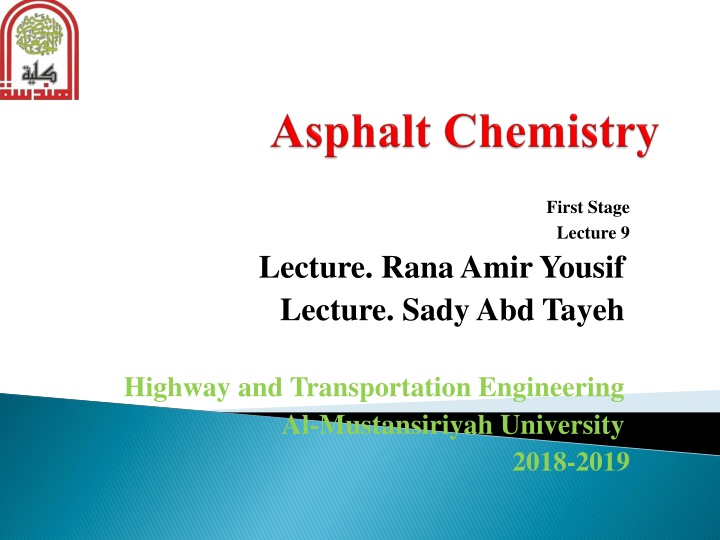
Understanding Asphalt Composition: Corbett's Chromatographic Method Explained
Discover Corbett's chromatographic method for analyzing asphalt composition, separating components like asphaltenes, saturates, naphthene aromatics, and polar aromatics. Learn how each component impacts asphalt properties and aging. Dive into the world of asphalt science and technology with this detailed explanation.
Download Presentation

Please find below an Image/Link to download the presentation.
The content on the website is provided AS IS for your information and personal use only. It may not be sold, licensed, or shared on other websites without obtaining consent from the author. If you encounter any issues during the download, it is possible that the publisher has removed the file from their server.
You are allowed to download the files provided on this website for personal or commercial use, subject to the condition that they are used lawfully. All files are the property of their respective owners.
The content on the website is provided AS IS for your information and personal use only. It may not be sold, licensed, or shared on other websites without obtaining consent from the author.
E N D
Presentation Transcript
First Stage Lecture 9 Lecture. Rana Amir Yousif Lecture. SadyAbd Tayeh Highway and Transportation Engineering Al-Mustansiriyah University 2018-2019
References: Edwin J. Barth. Asphalt Science and Technology , 1st Ed. ,1962. James Speight Asphalt Materials Science and Technology , 1st Edition 2015.
(2) (chromatographic) method. This method (ASTM D4124) developed by Corbett uses selective adsorption desorption procedures and actually separates the components virtually unaltered for further analysis. The most polar and least soluble asphalt cement components (asphalrenes) are first precipitated by n-heptane which is a nonpolar solvent. The heptane solution of the remaining maltene fraction is then introduced into a chromatographic column. Alumina in the column adsorbs the remaining three components. Corbett's selective adsorption-desorption
Corbett's method separates and quantifies the following four components: Asphaltenes (A) Asphaltenes precipitated by n-heptane are most polar and act as the "bodying" fraction of asphalt cement as discussed earlier. They are solid or semi-solid at ambient temperature. Saturates (S) Saturates are the first fraction to emerge from the column when eluted (desorbed) with n-heptane. This fraction is not adsorbed by the alumina in the column because it lacks polar chemical functional groups. Saturates are equivalent to paraffins in the Rostler analysis. Often sulfur is found incorporated in molecules of this fraction. They are liquid at ambient temperatures and hardly change with time. They have a negative contribution to temperature susceptibility of asphalt cement.
NaphtheneAromatics (NA) Naphthene aromatics emerge as the second fraction when eluted with a more polar aromatic solvent such as benzene or toluene. Their molecular structure is comprised of condensed nonaromatic and aromatic ring systems, and may contain the heteroatoms oxygen, nitrogen and sulfur. They are liquid at ambient temperatures. They are considered to be the softening component in asphalt cement. They are also the aging fraction in asphalt cement. Polar Aromatics (PA) They are the final fraction to emerge from the column when eluted with a highly polar mixture of alcohol and benzene (or toluene). Alcohol helps to debond this strongly adsorbed and most polar component of the maltenes from the absorbent (alumina). Its molecular structure comprises a higher percentage of condensed aromatic ring systems and functional groups containing heteroatoms than the other fractions of maltenes. It is solid or semi-solid at ambient temperatures. It has been related to ductility of asphalt cement and is also one of the aging fractions in asphalt cement.






















